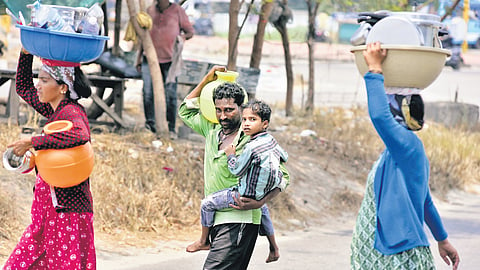

It’s a strange paradox. There is general appreciation that poverty is on the decline. It is driven by robust development spending by the government, and a marked trickle-down effect. On the other hand, inequality has risen sharply with recent studies suggesting that with 1% of the richest Indians owning 40% of the wealth, India is more ‘unequal’ than even Brazil, South Africa and the U.S.
In its recent release, the country’s official planning body, the Niti Aayog said ‘multidimensional’ poverty had fallen to 11.3% from over 29% a decade ago. In absolute numbers, it estimated that 248 million people had ‘escaped’ poverty over the last 9 years. ‘Multidimensional poverty’ is a new local standard based on a spectrum of indicators categorized under health, education and living standards.
The World Bank has a different ‘consumption’ standard for assessing poverty levels, a more acceptable currency among economists. However, the international lender too conceded: “Between 2011 and 2019, the country is estimated to have halved the share of the population living in extreme poverty –with an income of below $2.15 (about `180) per person per day.” In 2021, about 11.9% (higher than the Niti Aayog figure) lived below the poverty line – lower than the pandemic high of 14.7% in 2020, but still marginally higher than in 2018.
Class divide worsens
Logically, inequality in both wealth and income should have proportionately gone down. Unfortunately, it has moved the other way. The widely publicized study from the Paris-based World Inequality Lab, authored by 4 highly respected economists – ‘Income and Wealth Inequality in India – The Rise of the Billionaire Raj’ – has posited that during 2014-15 to 2022-23,inequality in both wealth and income reached their historical highs. The richest top 1% of the population controlled 40.1% of the national wealth in 2022-23, the highest level since 1961.
The story is the same on income distribution. “Our results point to extreme levels of inequality in India compared to international standards. In 2022-23, 22.6% of national income went to just the top 1%, the highest level recorded in our series since 1922, higher than even during the inter-war colonial period…In other words, the ‘Billionaire Raj’ headed by India’s modern bourgeoisie is now more unequal than the British Raj headed by the colonialist forces,” says the report.
It added a warning: “It is unclear how long such inequality levels can sustain without major social and political upheaval.” While there is a universal consensus on poverty – a curse that has to be removed – it is not the same for inequality. In an intensely stratified society with its layers of caste and religious groupings, inequality is institutionalized in India. There is a deep belief that people are positioned high or low on the income ladder because it is ordained; it is part of karma, and that is how society functions.
How does one otherwise explain the lack of mass revulsion at the recent, obscene splurge of wealth at a pre-marriage ceremony at Jamnagar for Ambani scion, Anant Ambani, and Radhika Merchant. Instead, it became a celebration of the world’s rich and famous from Ivanka Trump to Bill Gates and Marck Zuckerberg; and for entertainment, singer Rihanna performed.
Or, for that matter, in 2004, when about 40% of India was below the poverty line, Saharashri Subroto Roy celebrated a double wedding for his sons Sushanto and Seemanto splurging Rs 550 crore with 11,000 guests in attendance.
Except for a few diehard left and liberal critics, these eventsare acclaimed and broadcast as shows of power and style. Culturally, there is not an eyebrow raised at the huge class divide. There is no resentmentagainst pomp and wealth; instead those who don’t make it to the guest list celebratewith photographs and gossip. The ways of the rich and famous have aspirational value.
Distributive justice
But discontent there is and the demand for distributive justice is building up. Taxation is the common formula through which wealth concentrated in a few hands can be channeled for narrowing class chasms. We live in times where ‘tax’ is a bad word and 25-30% income / corporate tax still churns up resentment. We have forgotten the Nehruvian era where income tax for the top bracket touched 97%!
The wheel has turned a full circle and the debate for slowing inequality through better policy and a new tax code is again building. The World Inequality Lab says the Indian tax system is regressive and that we should consider a ‘super tax’ of 2% on net wealth of the 167 wealthiest families in 2022-23. This “would yield 0.5% of national income in revenues and create valuable fiscal space to facilitate such investments,” the report says.
It points to wider concerns, which we should take heed of. “One reason to be concerned with such high levels of inequality is that extreme concentration of incomes and wealth is likely to facilitate disproportionate influence on society and government….the integrity of various key institutions in India appears to have been compromised in recent years. This makes the possibility of India’s slide towards plutocracy even more real…“If only for this reason, income and wealth inequality in India must be closely tracked and challenged.”